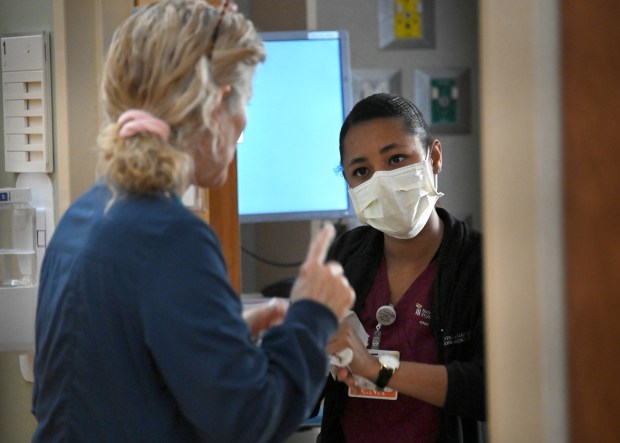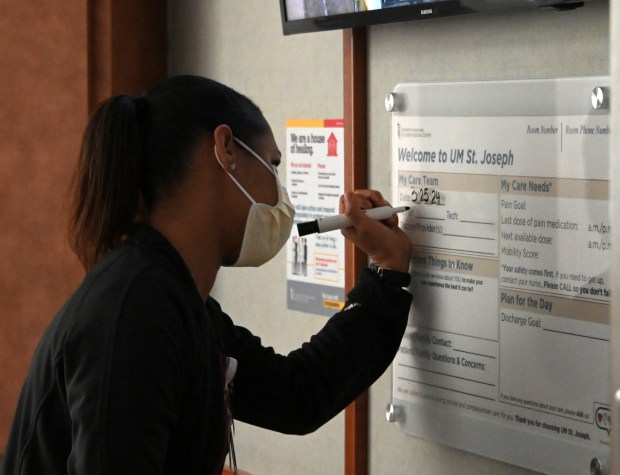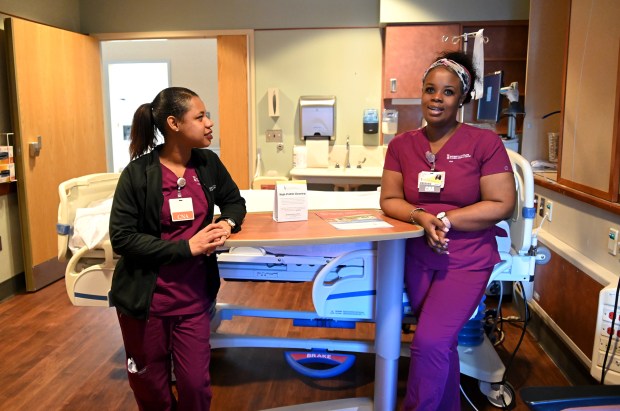The hospital needed nurses. Baltimore County was looking for more good jobs. This program helps both.
Being a nurse sounded like the perfect career for Danielle Gonzalez — at least on paper.
He already had experience working in the field of health. Before retiring to care for her third child, who was born with health problems, she worked as a certified medical assistant for about 10 years. In addition, she loved caring for others.
But when he looked at how much it would cost to go back to school, he lost hope. Her husband, a carpenter, supported the family with only one income. They lived paycheck to paycheck. It was hard enough to keep up with the cost of living and put food on the table.
“Okay,” he said to himself. “This is not real. I can’t do this.
Then, he read about Public Health Pathways – a workforce development pilot program created by Baltimore County, University of Maryland St. Joseph Medical Center and Community College of Baltimore County. Suddenly, a career in nursing didn’t seem out of reach.

The program, which welcomed its first cohort last June, covers the cost of unemployed and underemployed Baltimore County residents to attend community college to become certified nursing assistants, then nurses with license – a job that requires more training, but also comes with a higher salary.
After students become certified nursing assistants, they are offered guaranteed employment with full benefits at St. Joe’s Towson, where they can work while continuing their education. They also receive a monthly stipend of $1,000 to help with childcare, transportation, rent or other needs that may make it difficult to participate in the rigorous program.
Jennifer Lynch, senior policy advisor for education and personnel for Baltimore County Executive Johnny Olszewski Jr., described the program as the brainchild of Olszewski and Dr. Mohan Suntha, president and CEO of the University of Maryland Medical System. It is intended to deal with two problems at the same time: The strong need for health care workers and the problems that the economically disadvantaged residents of the district are trying to enter or continue to work.
To start the program, the medical system contributed $500,000 and Baltimore County contributed $675,000 of its American Rescue Plan Act funds. It’s part of the district’s effort to “reimagine” workforce development, Lynch said. While it’s nice to help someone get hired in the first place, the effort shouldn’t stop there, he said.
“Our mission is not just to get someone in the door, but to get them to a living wage for a family,” Lynch said.
Licensed practical nurses earned, on average, $59,730 per year in 2023, according to data from the US Bureau of Labor Statistics.
More than 500 people applied for the Pathways program when the application was released early last year, said Sandra Kurtinitis, president of the Baltimore County community college. Of that number, only 28 — including Gonzalez — chose to enroll in the college’s certified nursing assistant program.
From June to September last year, the students completed the training and were hired by St. Joe’s. Nine students decided to continue their education to become registered nurses.
Lynch and other supporters of the program consider it a victory. Typically, they said, only a small percentage of students enrolled in nursing degree programs graduate, and even fewer pursue higher education.
Gonzalez, who is already enrolled in a community college nursing program, will be the first to admit it’s a tough job. Still, he and other participants say the program is important.
Alicia Saunders, a single mother of a 12-year-old son, also decided against applying to nursing school after researching how much it would cost. When she saw an ad for the Health Promotion Program on Instagram, she said it felt like divine intervention.
Before enrolling in the program, Saunders worked in various administrative assistant roles at nonprofits in the Baltimore area. Becoming a licensed nurse will increase her family’s income and give her the opportunity to work in the field she loves, she said. He remembers the wonder he felt the first time he heard his heart murmur.
“Things like that during the tour are a big deal for me. It’s really exciting,” he said.

The Pathways program has received a lot of attention. Olszewski was invited to speak about it at the White House in November 2022, before the program began. And this year, state lawmakers sponsored legislation in the General Assembly that would continue to support the pilot program and expand it.
With the state facing a tough fiscal year, Olszewski knew the law could face challenges. Legislative staff estimated that implementing it would cost about $184,200 in fiscal year 2025 to develop the program and staff the advisory board, and about $829,500 in the next fiscal year for expenses continuing staffing and financial support for selected students. Costs can be “substantial,” depending on the number of students served and the services provided, depending on the legal budget and policy.
The program has the power to change the lives of families by increasing their access to income, Olszewski said. Maryland hospitals are also in dire need of nurses, with 1 in 5 vacant, according to data from the Maryland Hospital Association. Ultimately, Olszewski said, it’s an investment that can “more than pay for itself.”
“You’re going to see people who can afford to buy a house or a very expensive house, and they’re going to pay more property taxes,” he said. and more.”
Lawmakers agreed with him and other supporters of the program. The law is now awaiting the signature of Gov. Wes Moore to start working in June.
Although St. Joe’s has a relatively low turnover rate, as 1 in 4 nursing positions are vacant in other departments, said Nicole Beeson, the hospital’s senior vice president of patient care services and chief nursing officer. . The Pathways program has expanded the staffing pipeline at the medical center as a whole, Beeson said, and helps attract a diverse workforce so that its employees represent the communities they serve.
To support students participating in the program, St. Joseph created a new staff position to provide full-time training and coaching to them, Beeson said. The hospital also offers students paid study time, which allows them to put in a few hours during shifts for class work.
Helping with the Pathways program has been a “happy project” for him, Beeson said. She graduated from the nursing program at Baltimore County Community College herself. Taking weekend and evening classes, she was able to take care of her three young children while she earned her degree – which ultimately changed her family’s life. Now, one of her children is a nurse and the other is a physical therapist.
He said: “When you enter the work of caring for others, you think that you are going to care for other people, and you realize that caring for others really restores the caregiver.”

#hospital #needed #nurses #Baltimore #County #good #jobs #program #helps